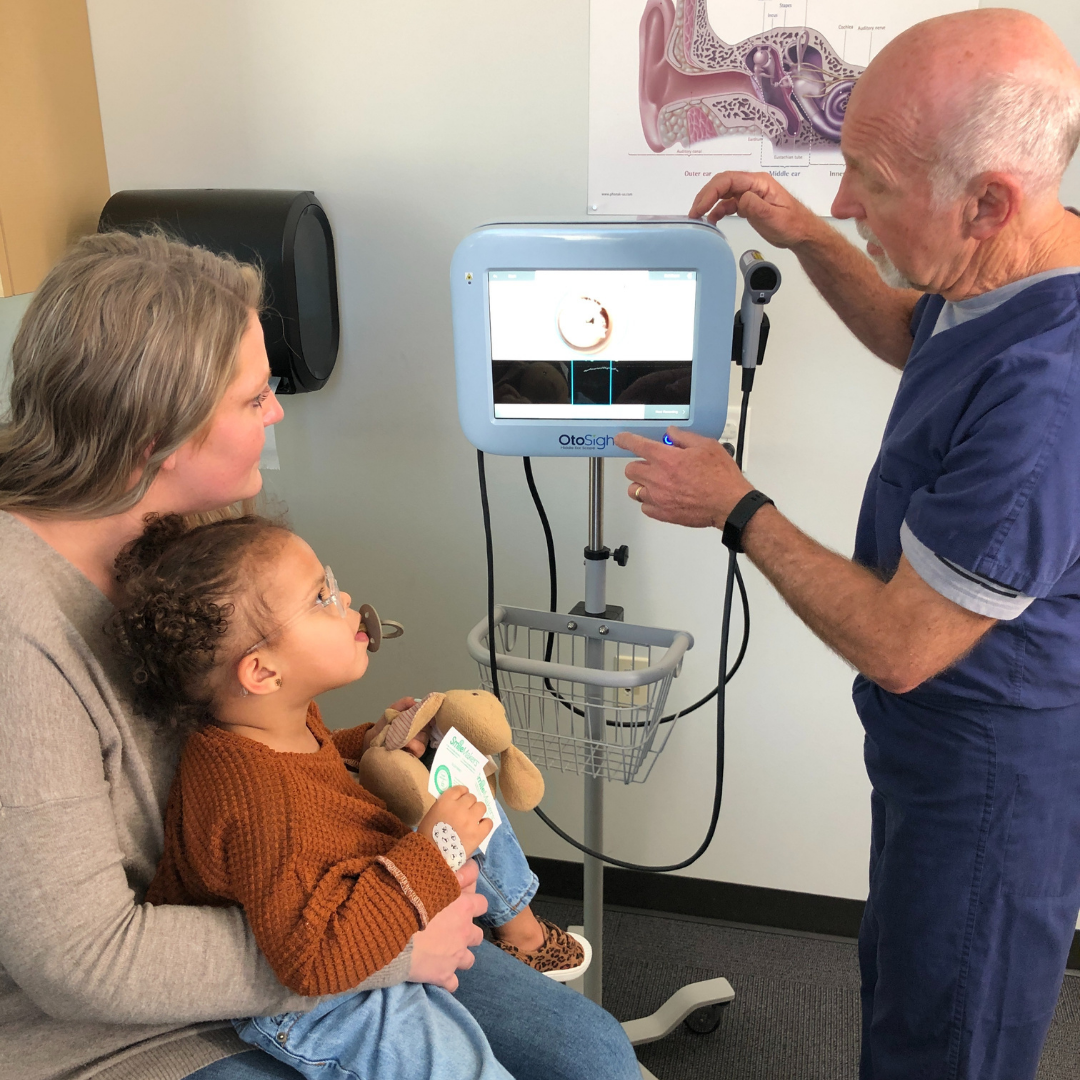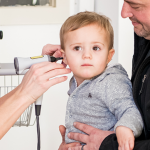Phone
866-411-EARS
Address
PhotoniCare Inc.
2800 Meridian Parkway, Suite 175
Durham, NC 27713

PhotoniCare sits down with Dr. Michael Novak, an Ear, Nose and Throat doctor from Carle Foundation Hospital in Urbana, Illinois, to chat about middle ear questions commonly asked in an ENT’s office.
Dr. Novak, before we dig into our questions, can you help us to define otitis media?
Otitis media, or middle ear infection, refers to inflammation, infection or fluid under the eardrum. Middle ear infections are most common in children.
Why do children get more ear infections when compared to adults?
Most ear problems stem from the eustachian tubes. Eustachian tubes are the tubes that connect the middle ears to the back of the nose. The tubes help the ears drain fluid and they also keep air pressure in the ears at the right level. Children are prone to more ear infections because this area within their ear is quite small/narrow compared to adults. Anything that makes the nose stuffy has the tendency to the block eustachian tubes underneath the ear drum. Swelling from colds or allergies can keep the eustachian tubes from opening and this leads to pressure changes and the collection of fluid in the middle ear. This pressure and fluid will cause pain and sometimes the fluid can lead to an infection. Therefore when kids get a cold, and the cold runs its course (over about 5-7 days), it’s usually about another 10-14 days after that the eustachian tubes start to clear and things clear up on their own.
Are there home remedies for ear infections?
Many primary and specialty care physicians push home remedies to avoid over-prescription of antibiotics. The old adage says “if a doctor treats you you’ll get better in one week, and if they don’t you’ll get better in seven days”. So we want to know, who has lingering problems? Who needs the treatment? That should be our primary focus. For home treatments – most are harmless and people can easily treat a cold or allergy with symptomatic treatments like over-the-counter antihistamines, decongestants, nose sprays, and such. Anything that makes the nose stuffy has the tendency to block the eustachian tubes underneath the ear drum. Treatments like holding your nose and gently popping your ears can provide relief and the more you do it the faster your ears may clear. Babies and young children typically cannot pop their ears, but popping may happen if they suck on a bottle or pacifier. Another home remedy is lukewarm salt water inserted into the nose and pulled out by hand bulb syringe.
How many ear infections must one have before tubes are considered as a form of treatment?
Standard guidelines say four acute ear infections over a six month period, or fluid that persists more than three months. However, a lot of factors are considered when recommending ear tubes. The time of year (persistent ear infections in the summer or fall months as opposed to winter months) as well as issues that may be impairing the child’s hearing and speech development. Physicians will most likely be less patient with standard guidelines especially with children that have speech delays due persistent ear infections.
I am noticing it is taking my daughter longer for speech development in comparison to her older siblings that didn’t suffer as badly from multiple ear infections. Should I be concerned about speech and language delays? Or potential hearing loss? What can we do?
Speech delay for many people is ill-defined. Children will develop at their own rate. However, the American Speech-Language Hearing Association offers charts that can tell you when most children who speak only one language will reach certain milestones. Not being able to master one skill in the age range does not mean that your child has speech and language delays. Although you may want to seek the guidance of your physician if you answer “no” for your child for most of the skills in the charts.
I know I’m not supposed to use cotton swabs to clean out my ears – so then what do I use instead?
Wax, or cerumen, is a good thing and harmless but occasionally it blocks up everything and can make it hard to hear or even for the physician to capture an adequate image inside the ear. Cotton swabs aren’t terrible when used on the outside opening of the ear (as long as you’re super cautious). Wax handling can be taken care of at home with one of the over-the-counter ear wax softening or ear irrigation kits. Doctors may also suggest patients try a home remedy of a few drops of baby oil in each ear, then wait 3-7 days to allow the wax to soften. At that point, the individual should get into the bathtub (because the next step may get a little messy). Fill a hand bulb syringe with half lukewarm water and half hydrogen peroxide and gently flush out each ear with this mixture. It makes a mess, but it’s the safest way to conduct this home remedy. For a really waxy kid, the buildup will continue to occur, so repeat this method every few months. If you really can’t get the ear(s) cleaned out then it can be done in a physician’s office. Certain groups of patients, such as those with hearing aids, will often have earwax buildup and should be routinely evaluated for cerumen impaction. The same goes for young children and cognitively impaired adults, who may be unable to express symptoms of cerumen impaction.
What made you want to become an otolaryngologist? Specifically, an Otologist specializing in ear disorders and surgery?
When I was in medical school I found that I really liked anatomy. I especially liked head and neck anatomy as well as head and neck surgery. It’s complex and I liked the challenge. From there I sub-specialized in the ears only. This specialization is even harder than just ear, nose, and throat (ENT). Ears are very small and very complex. There is a huge amount that we don’t know about hearing, hearing loss, and treatments. I find it all to be very challenging but the surgery, although often difficult, is very rewarding. I had a couple of mentors in medical school that were wonderful people and teachers that were talented in the art of patient care. They never forgot what they were there for – to take care of people. In my role I work with good people. We work as a team which makes a huge impact on the lives of both adults and children by improving their hearing. It has turned out to be a challenging and rewarding field.
I’m sure you are quite busy, but what do you do for fun?
I’m a huge Cubs fan! I have 7 grandchildren, 5 of which live close by. I enjoy reading and I also enjoy playing golf and tennis and going hiking.
Why do we want the OtoSight Middle Ear Scope?
Diagnosing an ear infection in children can be difficult. Most people can recognize that because a child becomes upset and develops a fever. But realistically it can be very difficult to know if there is fluid underneath the eardrum. Most diagnosis of ear infections are at the primary level, emergency department, or convenient care. So if we can have an objective measure like the OtoSight Middle Ear Scope to tell if you have fluid or not – it is huge! It helps us to better understand if there is fluid and whether or not we should treat. It’s a huge benefit to children and their families, not to mention the cost to society in general. This device will revolutionize how we diagnose ear infections. One of these days it will be the standard in all offices and people will feel lost without it.

The COVID-19 pandemic has created numerous challenges for parents. Navigating… Read More

This week on the #EnginEarGuys blog we talk about otolaryngology… Read More

For some children, ear infections seem unavoidable. With the cold… Read More